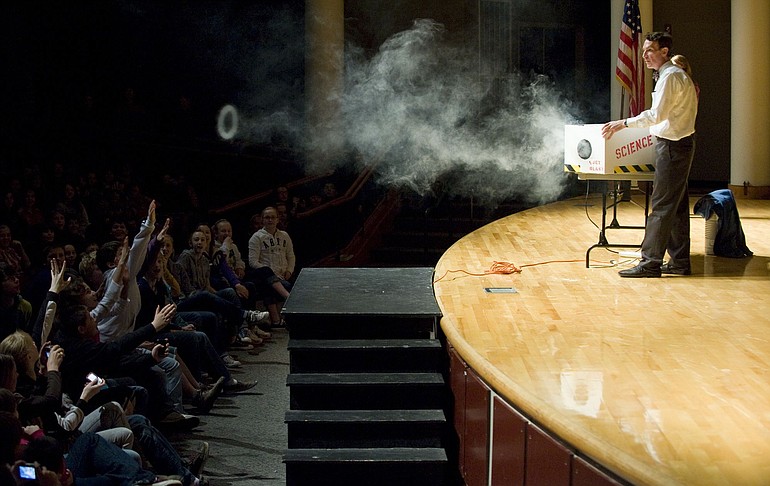Serenaded by the piercing roar of a thousand sixth-graders, a bow tie-wearing science geek bounded down the aisle of the Skyview High School auditorium Thursday morning.
“I want you to change the world,” Bill Nye implored the students. “With science.”
Nye trained as a mechanical engineer.
But the rock-star reception accorded him by the auditorium full of Vancouver youngsters is due to his television persona as Bill Nye the Science Guy. Nye served as writer, producer and host of the public television show produced in Seattle from 1992 to 1998.
Nye’s visit was coordinated by the Mount St. Helens Institute.
Besides the invitation-only event at Skyview, the institute also hosted a public presentation Thursday evening in Portland as a fundraiser for the nonprofit organization. Nye, who lives in Burbank, Calif., serves on the group’s board of directors.
Nye said it’s not hard to get students excited about science.
“How can you not be excited about science?” he said in an interview backstage. “What’s more fun than science? I like English as much as the next guy — maybe more — but with science you’ve got props. You’ve got things you can blow up. What’s not to love about that?”
Likewise, he said, it doesn’t take much to demonstrate the significance of an eruption that occurred well before today’s sixth-graders were born.
On May 18, it will have been 30 years since the biggest landslide in recorded history uncorked an eruption that killed 57 people, leveled 150 square miles of forest and jetted a 15-mile-high plume of ash that turned day into night as far as Montana. When it ended, 1,314 feet of mountaintop had been obliterated.
“Thirty years wasn’t that long ago,” Nye said. “I mean World War II affected me, but I wasn’t alive. It’s part of history. You have to learn to appreciate it. Even if you weren’t killed or horribly inconvenienced by an eruption, you have to be aware of it and prepare for it.”
The 55-year-old Nye stokes a youthful sense of wonder when it comes to the most active volcano in the Pacific Northwest.
“The forces of the universe blew up an entire mountain,” he said. “I mean, that’s exciting.”
During his hourlong presentation, Nye showed students how Mount St. Helens and the rest of the Cascade Range delineate the edge of an offshore tectonic plate diving beneath North America. Similar zones of tectonic convergence produce the line of volcanoes around the Pacific Ocean known as the Ring of Fire.
“Not everybody in the world gets to live at a crease in the plates, people,” Nye said.
The notion of plate tectonics — that the Earth’s surface is broken into numerous movable slabs each about 50 miles thick — is now widely accepted in middle school classrooms worldwide. However, Nye told the students that the theory evolved during the course of his lifetime.
“What else is there in nature that we’ve never thought of that’s right under our noses?” he said.
With that, he squeezed a single drop of ink into a pitcher of water. The idea was to demonstrate pre-industrial levels of carbon dioxide in the Earth’s relatively thin atmosphere — about 280 parts per million. The concentration had risen to 379 ppm as of 2005, primarily due to the burning of fossil fuels.
“It seems like a tiny amount,” Nye said, “but it’s enough to change everything for everyone on Earth.”
A second drop represented the post-industrial buildup of carbon in the atmosphere. The water turned a deep shade of purple.
The Earth itself will come out just fine as the climate changes with the buildup of greenhouse gases in the atmosphere, Nye said, but it will become increasingly less hospitable for humanity. “I want to save the Earth for me, for humans. Some of my best friends are humans,” he quipped.
He challenged the sixth-graders to figure out new ways to do more with less: Design more efficient buildings, engineer better building materials, devise a longer-running battery.
“If you could invent a better battery, you guys would get rich — Bill Gates rich,” he said. “And you would change the world.”
Erik Robinson: 360-735-4551, or erik.robinson@columbian.com.



